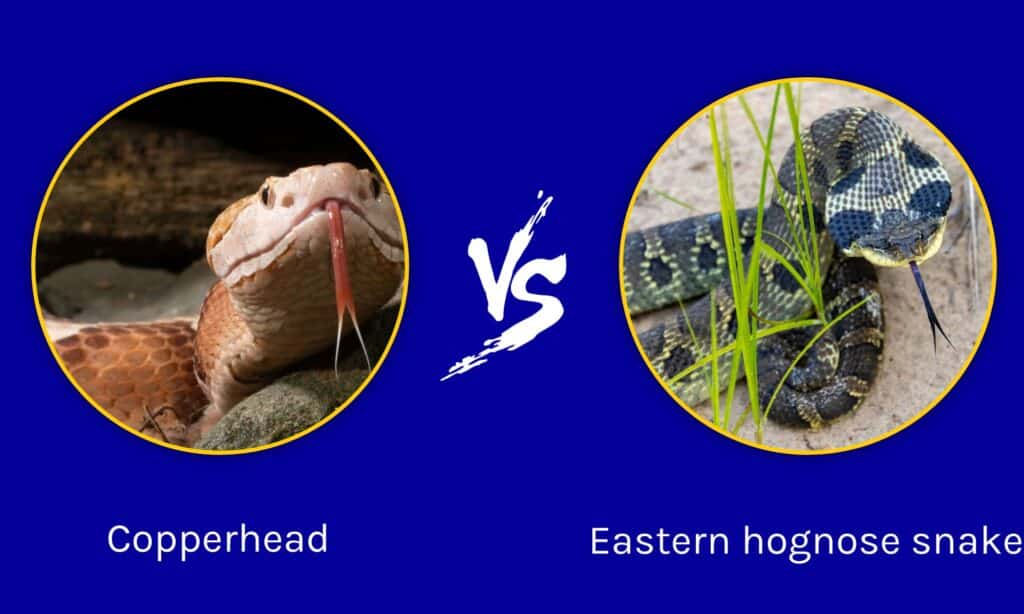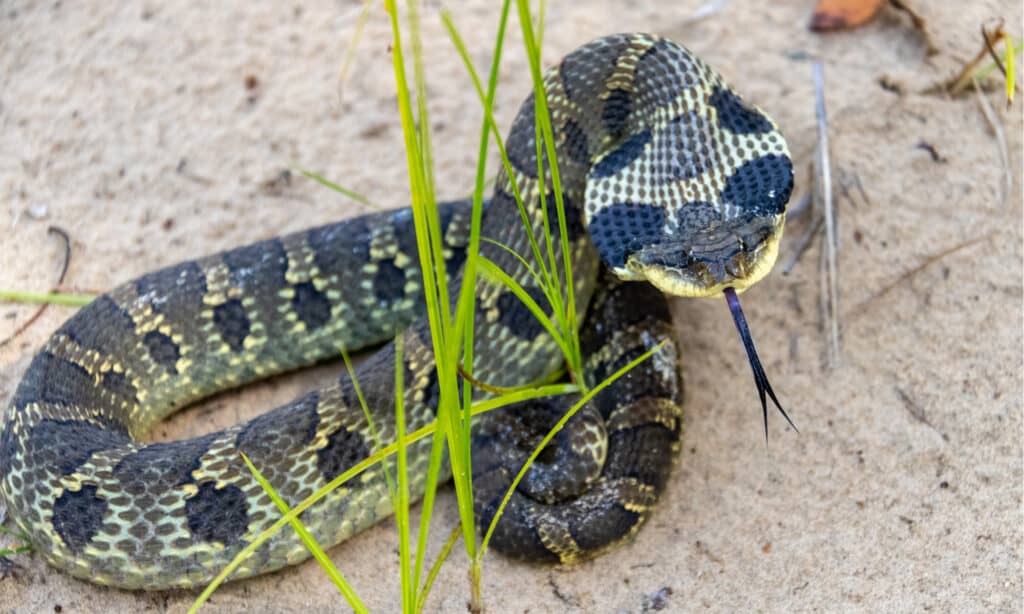Copperheads and eastern hognose snakes are both medium-sized snakes that are endemic to North America. Copperheads are one of the most well-known snakes native to North America. However, as they are both heavy-bodied snakes with very similar markings, they can be difficult to tell apart. So join us as we discover everything you need to know about copperheads vs eastern hognose snakes!
Comparing Eastern Hognose Snake vs Copperhead

| Eastern Hognose | Copperhead | |
|---|---|---|
| Size | 20 to 33 inches | 20 to 37 inches |
| Habitat | Areas with loose, sandy soil – upland pine forests, field edges | Deciduous forests, mixed woodlands, rocky outcrops, low-lying swamp regions |
| Color | Varied – yellow, tan, brown, gray, orange, or red with dark brown or black blotches | Pale to pinkish tan with dark reddish-brown crossband markings – usually in an hourglass shape |
| Snout | Upturned | Flat |
| Venomous | Not venomous to humans | Venomous |
| Defensive Behavior | Flattens neck and raises head like a cobra | Freeze, then strike if stepped on |
| Reproduction | Oviparous | Ovoviviparous |
| Diet | Amphibians – particularly toads | Varied – invertebrates, lizards, snakes, birds, rodents, amphibians, turtles |
| Predators | Raccoons, opossums, red foxes, hawks, kingsnakes | Owls, hawks, kingsnakes, cottonmouths, black racers, raccoons |
The 6 Key Differences Between Copperheads and Eastern Hognose Snakes
The key differences between a copperhead and an eastern hognose snake include habitat, appearance, venom, snout, defensive behavior, and reproduction.
Copperheads are pit vipers from the Viperidae family group which is a group of venomous snakes that are found everywhere except Antarctica, Australia, Hawaii, Madagascar, and other small islands. They are widespread within their range and are often encountered by humans.
Eastern hognoses are members of the Colubridae family group which is the largest snake family. Members of Colubridae are found on every continent except Antarctica. Eastern hognose snakes are also known as spreading adders and are solitary snakes that are active during the day and early evening when they are most likely to be seen. While not quite as well known as copperheads, eastern hognoses are particularly unique due to their appearance and the way that they are specially adapted to eating their chosen prey.
Copperhead vs Eastern Hognose: Appearance

Copperhead snakes are usually tan with darker crossband markings.
©Dennis W Donohue/Shutterstock.com
Copperheads have thick, strong bodies and keeled dorsal scales but their appearance is much more uniform across the species. They are typically a pale or pinkish-tan color with large crossband markings. The crossbands are usually a dark, reddish-brown color and form the shape of hourglass shapes on their back. The markings on their sides typically have lighter centers and darker edges.
Eastern hognose snakes have stout bodies, strongly keeled dorsal scales, and a highly varied appearance. Their base colors can range between red, orange, yellow, tan, brown, and grey. However, they also usually have many dark brown or black blotches across their bodies. The blotches are typically larger on their back and smaller on their sides.
Copperhead vs Eastern Hognose: Snout
Easily the most obvious difference between these two snakes is the appearance of their snout. Eastern hognose snakes have a distinctive upturned snout which they use for digging and burrowing into the soil. Copperheads have a flat snout with a deep pit located between the nostrils and the eyes. This pit is a heat-sensing organ that is present on all pit vipers and allows them to detect warm-blooded animals by their thermal radiation.
Copperhead vs Eastern Hognose: Habitat
Where they are located also gives us a clue as to which snake is which as they usually reside in different habitats. Eastern hognose snakes prefer habitats with plenty of loose, dry, and sandy soil – such as upland pine forests, field edges, and farmland. This allows them to dig and burrow easily using their upturned snout.
Copperheads prefer areas with plenty of leaf litter for them to hide in – such as deciduous forests and mixed woodlands. They are also often found in low-lying swamp regions or areas surrounding stream beds and river bottoms. Copperheads use large logs or rocks to shelter underneath. However, during the winter they hibernate in burrows or crevices with black rat snakes and venomous timber rattlesnakes.
Copperhead vs Eastern Hognose: Venom
The most important difference is that one snake is venomous to humans while the other is not. Copperheads are venomous pit vipers, although they are not particularly aggressive snakes and bites are rarely fatal. Rather than releasing their venom straight away, copperheads tend to employ a “warning bite” first where they bite without injecting any venom. This is also known as a “dry bite”. Symptoms of a copperhead bite include swelling, pain, tingling, and nausea.
Copperheads are ambush predators and kill their prey by injecting them with their venom. They have an extremely varied diet and eat a wide range of insects, birds, rodents, amphibians, lizards, and other snakes. Although they bite and hold smaller prey until they are dead before consuming them, copperheads often release larger prey after biting them and injecting them with venom. After releasing their prey, copperheads then track them using their sense of smell and taste while they wait for them to die from the effects of the venom.
Eastern hognose snakes are technically venomous, despite not being venomous to humans. This is because they are mildly venomous to their prey only. Eastern hognose snakes are from the genus Heterodon which literally means “different tooth”. They are rear-fanged and produce a mild venom-like substance in their Durvenoy’s gland. Occasionally, allergic reactions to bites may occur, but this is rare.
Eastern hognose snakes prey exclusively on amphibians, with toads being their main source of food. They inject their venom into the toads in order to immobilize them while they swallow them whole. Interestingly, while eastern hognose snakes are venomous only to their prey, they themselves are immune to the toxins that toads produce. This is because they have large adrenal glands which produce enough hormones to counteract the effects of the poison.
Copperhead vs Eastern Hognose: Defensive Behavior

When threatened, eastern hognose snakes flatten their necks and raise their heads like a cobra.
©IHX/Shutterstock.com
Another noticeable difference between eastern hognoses and copperheads is how they react in the face of a threat – although you probably don’t really want to be close enough to find out! Copperheads tend to freeze rather than flee when they are disturbed. As they are usually very well camouflaged amongst leaves, this is the reason why they are often unwittingly stood on and this is when they are most likely to bite in defense.
Although they are not venomous to humans, eastern hognose snakes often react like a venomous cobra when they are threatened. They flatten their neck and raise their head from the ground – often accompanied by a lot of hissing. Eastern hognoses also sometimes strike while they are doing this but they usually keep their mouth closed and use it merely as an attempt to deter their predator. Eastern hognoses also sometimes take things further if that doesn’t work and “play dead” by rolling onto their back with their tongue hanging out and producing a strong musk smell.
Copperhead vs Eastern Hognose: Reproduction
Eastern hognose snakes and copperheads also have very different methods of reproduction. Copperheads are ovoviviparous whereby their eggs hatch inside the female’s body and they then give birth to live young. Juvenile copperheads are around 8 inches long when they are born and litter size can be anything between 4 and 20. The young snakes are very similar in appearance to the adults, although a little lighter colored and with a yellow or green tip on their tails.
Eastern hognose snakes are oviparous and lay eggs that hatch outside of the body. Eggs are usually laid in burrows or underneath rocks and clutches consist of between 8 and 40 eggs. The eggs hatch after approximately 60 days and the hatchlings are usually between 6.5 and 8 inches long.
The photo featured at the top of this post is © iStock.com/David Kenny
Discover the "Monster" Snake 5X Bigger than an Anaconda
Every day A-Z Animals sends out some of the most incredible facts in the world from our free newsletter. Want to discover the 10 most beautiful snakes in the world, a "snake island" where you're never more than 3 feet from danger, or a "monster" snake 5X larger than an anaconda? Then sign up right now and you'll start receiving our daily newsletter absolutely free.
FAQs (Frequently Asked Questions)
Are there any subspecies of copperheads and eastern hognose snakes?
There are no recognised subspecies of eastern hognose snakes, but the subspecies of copperheads are often debated. There was originally five subspecies which were recognized, but these have now been reclassified. Three subspecies are now classified simply as the original species – eastern copperheads. However, two are now classed as their own distinct species – broad-banded copperheads. This means that there is now officially no recognized subspecies at all.
Thank you for reading! Have some feedback for us? Contact the AZ Animals editorial team.






